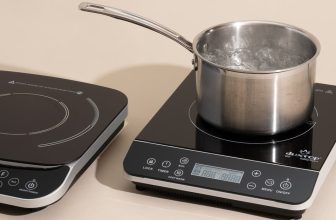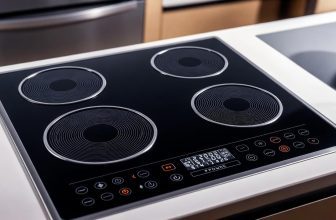As an Amazon Associate I earn from qualifying purchases.
Do Induction Cooktops Require Special Pans?
Do Induction Cooktops Require Special Pans? Think about this: 90% efficiency in cooking sounds like a dream, right? Yet, induction cooktops can achieve this remarkable feat, but only with specific cookware. The magic lies in the pan’s material – it must contain ferromagnetic metals.
Historically, cast iron and stainless steel have been the go-to choices for induction cooking. Their magnetic properties ensure the cooktop’s electromagnetic field effectively heats the pan. Interestingly, a quick check with a magnet can easily confirm if your pan will work on an induction cooktop.
:max_bytes(150000):strip_icc()/what-is-the-best-cookware-for-induction-cooktops-908920-ADD-FINAL-f6191a5ca3274837a72ec3205dfaced5.png)
Do Induction Cooktops Require Special Pans?
Induction cooktops have a unique way of heating food, which involves magnetic fields. This method means that the cooktop can only work with pans made of ferromagnetic materials. Common materials that work well include cast iron and stainless steel. However, aluminum, copper, and glass pans won’t work unless they have a magnetic bottom layer. This makes picking the right pan essential for induction cooking.
Using the wrong pan leads to frustration since the cooktop won’t heat up. To easily check if your pan is compatible, just use a magnet. If the magnet sticks to the bottom of the pan, it will work with your induction cooktop. Some modern pans even have labels indicating their compatibility. Look for these labels when shopping for new cookware.
In terms of performance, induction-compatible pans heat quickly and evenly. They also make cooking more efficient because less energy is wasted. Using the right pan can improve your cooking experience and save you time in the kitchen. Here’s a quick list of excellent materials for induction pans:
- Cast Iron
- Magnetic Stainless Steel
- Carbon Steel
- Enamel-Coated Cast Iron
Most induction cooktops come with user manuals that suggest which pans to use. Following these guidelines ensures optimal performance. Manufacturers also offer sets of induction-compatible cookware. These sets take the guesswork out of selecting the right pans for your kitchen.
Science Behind Induction Cooking and Specific Pan Requirement
Induction cooking works through electromagnetic fields. An induction cooktop has a coil of copper wire underneath its surface. When you turn on the cooktop, an electric current passes through this coil, creating a magnetic field. This magnetic field then induces an electric current in the pan, generating heat directly. Because the heat is created in the pan itself, the cooking process is more efficient.
The material of the pan plays a big role in how well this process works. For induction cooking to be effective, the pan must be made of or contain ferromagnetic metals like iron or steel. These metals interact with the magnetic field to generate heat. Without these metals, the pan won’t get hot. This is why some pans work, and others don’t.
Not all ferromagnetic pans are created equal. Some materials conduct heat better than others. Here’s a comparison:
| Material | Effective Heat Conductivity |
|---|---|
| Cast Iron | Excellent |
| Magnetic Stainless Steel | Good |
| Carbon Steel | Very Good |
| Enamel-Coated Cast Iron | Very Good |
Using ferromagnetic pans not only ensures compatibility but also improves cooking efficiency. Induction cooktops paired with the right pans heat food quickly and evenly. This type of cooking also minimizes energy loss. Therefore, investing in the right pans is beneficial for both performance and energy savings.
Why Certain Pans Work and Others Don’t on Induction Cooktops
The key to understanding why some pans work on induction cooktops lies in their materials. Magnetic fields interact with ferromagnetic materials to create heat. This means pans must have a magnetic property for induction cooktops to work. Common effective materials include cast iron and certain types of stainless steel. Pans made of these materials heat quickly and evenly.
On the flip side, pans made of non-magnetic materials like aluminum, copper, or glass won’t work. These materials do not interact with the magnetic field. Even if they have amazing heat conductivity in traditional cooking, they’re useless on induction cooktops. However, some manufacturers have started creating pans with magnetic bases. This makes them compatible with induction cooktops while retaining the benefits of their original materials.
Here’s a quick comparison of materials:
| Material | Induction Compatibility |
|---|---|
| Cast Iron | Yes |
| Stainless Steel | Yes, if magnetic |
| Aluminum | No, unless it has a magnetic base |
| Copper | No, unless it has a magnetic base |
| Glass | No |
To avoid guesswork, do a simple magnet test at home. If a magnet sticks to the bottom, the pan will work with an induction cooktop. This quick test can save you from buying the wrong cookware. Reading product descriptions for keywords like “induction-compatible” also helps in making the right choice.
Quick Tips for Identifying Induction Compatible Pans
Identifying induction-compatible pans is easier than it seems. One of the most straightforward methods is the magnet test. Simply take a magnet and place it at the bottom of the pan. If it sticks, the pan is suitable for induction cooking. This simple test saves time and effort.
Another way to identify compatible pans is by checking labels. Manufacturers often indicate if their cookware is induction-ready. Look for symbols or phrases like “induction-compatible” on the packaging or the bottom of the pan. This can be especially helpful when shopping online or in stores.
Materials play a critical role in compatibility. Here’s a list of common materials that work well:
- Cast Iron
- Magnetic Stainless Steel
- Carbon Steel
- Enamel-Coated Cast Iron
Some newer pans come with a combination of materials to enhance compatibility and performance. For instance, an aluminum pan with a magnetic stainless steel base can work on an induction cooktop. These pans offer the advantages of both materials, such as even heat distribution and magnetic interaction. It’s like getting the best of both worlds.
Lastly, consult the user manual of your induction cooktop. Most manuals recommend specific types of cookware. Following these guidelines ensures optimal performance and extends the life of your cooktop. Taking a few minutes to read the manual can provide valuable insights and save you from potential mistakes.
Advantage of Using Suitable Pans with Induction Cooktops
Using the right pans with induction cooktops offers numerous benefits. One significant advantage is energy efficiency. Induction cooking heats pans directly, reducing energy waste. This means your food cooks faster, saving both time and electricity. The kitchen also remains cooler, adding comfort while cooking.
Another benefit is precise temperature control. Induction cooktops respond quickly to temperature adjustments. This rapid response allows for more accurate cooking, helping to prevent overcooking or burning. Achieving perfect results becomes easier when the pans used are compatible. Cookware must be ferromagnetic for these benefits to be fully realized.
Durability and longevity are also boosted when using suitable pans. Induction cooktops are gentle on the pan’s surface. This minimizes wear and tear, extending the lifespan of your cookware. Proper pans also help maintain the condition of the cooktop itself, reducing the risk of scratching or other damage.
Cleaning becomes a breeze with induction-compatible pans. Because the cooktop itself doesn’t get hot, spills don’t burn onto the surface. This makes it easy to wipe clean after cooking. Time spent on kitchen maintenance is greatly reduced.
Here’s a quick table summarizing the advantages:
| Advantage | Benefit |
|---|---|
| Energy Efficiency | Reduces energy waste |
| Precise Temperature Control | Improves cooking accuracy |
| Durability | Extends cookware lifespan |
| Easy Cleaning | Less time on maintenance |
In summary, using suitable pans with induction cooktops leads to better cooking results and a more enjoyable kitchen experience. The right cookware ensures optimal performance and longevity. It’s a smart investment for anyone who loves to cook.
Frequently Asked Questions
Induction cooktops are becoming popular due to their efficiency and speed. Below, we answer some common questions about their use and compatibility with cookware.
1. How do induction cooktops heat food?
Induction cooktops work by creating a magnetic field between the cooktop and the pan. This magnetic field induces electric currents in the pan, generating heat directly in the cookware. As a result, the pan itself heats up while the cooktop remains relatively cool.
This method is more efficient than traditional gas or electric stoves because it minimizes energy loss. The heat is transferred directly to the food, making cooking faster and more precise. That’s why selecting suitable pans is crucial for optimal performance.
2. What materials are best for induction cookware?
The best materials for induction cookware are ferromagnetic metals like cast iron and certain types of stainless steel. These materials interact well with the electromagnetic field generated by the induction cooktop, creating efficient and even heating.
Pans made from these materials typically provide excellent cooking results on an induction stove. Aluminum or copper pans can work if they have a magnetic base, but pure aluminum or copper won’t be effective on an induction cooktop without this feature.
3. Can I use regular pots on an induction cooktop?
You can use regular pots on an induction cooktop only if they contain ferromagnetic materials like iron or steel at their base. To check compatibility, see if a magnet sticks to the bottom of your pot; if it does, it’s suitable for use.
If your regular pots aren’t compatible, you might need new ones designed specifically for induction cooking. Manufacturers often label these products as “induction-compatible” to make shopping easier for consumers.
4. Are there any special maintenance tips for induction cookware?
Caring for your induction cookware involves typical cleaning practices like washing with mild soap and avoiding abrasive scrubs that could damage the surfaces. Additionally, always make sure to dry them properly to prevent rusting in cast iron pans.
It’s also important not to drag heavy pans across the glass surface of an induction stove to avoid scratches or cracks. Store your cookware carefully to prevent any damage that might affect performance.
5. What happens if I use a non-compatible pan on an induction cooktop?
If you use a non-compatible pan on an induction cooktop, it simply won’t heat up because there’s no interaction with the magnetic field created by the appliance.
Your food will remain uncooked until you switch to suitable cookware containing ferromagnetic material.
Some advanced models may display an error message indicating incompatibility.
</last paragraph before start again .. Conclusion
Choosing the right pans for your induction cooktop significantly enhances your cooking experience. Induction-compatible cookware ensures efficiency, energy savings, and precise temperature control. It also prolongs the life of both your cooktop and your pans, making it a valuable investment for any kitchen.
Understanding the specific requirements for induction cooking allows you to make informed decisions. Whether testing your existing pans with a magnet or purchasing new, labeled cookware, these steps ensure optimal performance. Embrace the benefits of induction cooking with the right tools at your disposal.






